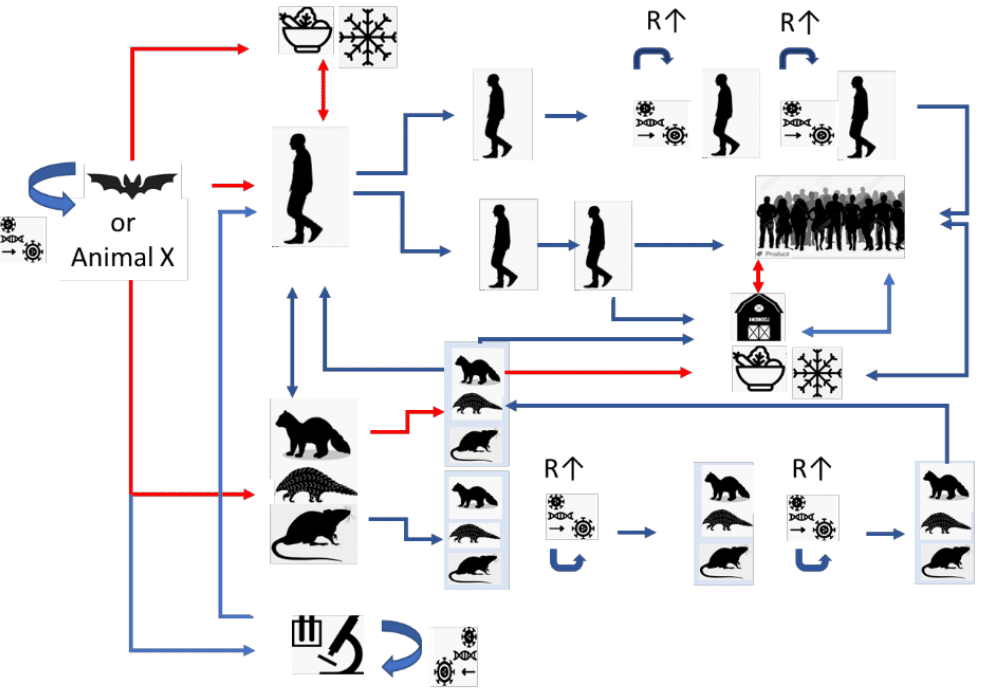
Schema for the introduction of SARS-CoV-2 through the cold/food chain, from the "
". (WHO)
It’s official. The much anticipated joint-World Health Organization (WHO)-Chinese report on the origins of COIVD-19 is in. The 120-page document details findings from epidemiology, molecular biology, DNA sampling, community canvassing, supply chain tracing, and more to trace the first emergence of the virus before the world learned of it in January 2020.
But what isn’t in the report? Any definitive conclusion about where the virus came from.
For that, folks will have to wait, months, years, or—gasp—more than a millennium. (One of the WHO investigators noted Tuesday that it took 1,500 years to understand how measles emerged.) Buckle up, because determining the origins of the 21st century’s worst pandemic—so far—could take a while.
“This is a dynamic process, nothing is cast in stone,” team lead Peter Ben Embarek told reporters Tuesday. “There are no firm conclusions. And I think that’s how we should look at the whole outcome of this report and this work.”
The report, based on the WHO team’s visits to sites in Wuhan, China, along with their work with Chinese counterparts earlier this year, listed four hypotheses about how the virus emerged in humans, ranking them in terms of likelihood. The group, which Ben Embarek said operated on consensus, believes that the most likely pathway is one many experts have long suspected: SARS-CoV-2 leapt from bats to some intermediary animal—similar viruses have been found in pangolins and farmed animals like minks have also been infected—and then into humans. The investigators decided that pathway was “likely to very likely.”
Other possibilities the team analyzed included the virus leaping directly from a bat to a person, being introduced on frozen food, and, most controversially, spreading after a research accident.
At Tuesday’s press conference, the team framed the report as a starting point to guide further investigation. That investigation could take future research beyond the borders of China, in search of bats in China or even South East Asia or food sources elsewhere. “The current thinking is still that we are looking at the start in and around Wuhan, and moving backwards, trying to find out how we came there. And whether it came from another part of China, or elsewhere—that will depend on the further studies and research,” Ben Embarek said.
Some experts argue more study within Wuhan is needed, to rule out the possibility that the initial outbreak was sparked by an accident at one of the laboratories that researched bat coronaviruses in the region. The WHO director-general Tedros Adhanom Ghebreyesus appeared to agree with them. “Although the team has concluded that a laboratory leak is the least likely hypothesis, this requires further investigation,” he said, according to The Washington Post. He said he might send future missions to explore the possibility.
The WHO COVID-19 origins team also appeared to acknowledge that a more thorough investigation would be needed to assess the lab leak scenario. “A true forensic examination of a laboratory, like one might do other types of forensic examinations, is a much more complex process and that’s not what we are there to do,” said Dominic Dwyer, an Australian member of the WHO team.
While the report ranked the possibility of a lab leak as “extremely unlikely,” it ranked another hypothesis that other experts have considered remote as “possible,” and grounds for further investigation: that the outbreak could have started with food or frozen food, potentially at the Huanan Seafood market in Wuhan that has been the focus of so much speculation. Some outbreaks in China have been linked to imported frozen food, but as the report notes, there’s no “conclusive evidence for foodborne transmission of SARS-CoV-2. … While there is some evidence for possible reintroduction of SARS-CoV-2 through handling of imported contaminated frozen products in China since the initial pandemic wave, this would be extraordinary in 2019 where the virus was not widely circulating.”
In other words, it’s possible, but unlikely.
Still, the report suggests following up on any “credible links to products from other countries or regions with evidence for circulation of SARS-CoV-2 before the end of 2019.” But while concrete evidence of a lab leak is similarly lacking, the team took a different approach, offering a comparatively anodyne course of action: “Regular administrative and internal review of high-level biosafety laboratories worldwide. Follow-up of new evidence supplied around possible laboratory leaks.”
That the WHO team is keeping the frozen food theory alive is sure to please some in the Chinese government. Some officials and state media in China have promoted a so-called “multiple-origin” scenario, according to CNN, where the pandemic started with outbreaks in different parts of the world. The report however, is sure to disappoint the scientists, researchers, and officials who suspect a lab leak could have started the pandemic.
And officials in Washington and elsewhere quickly cast doubt on the WHO team’s conclusions. Fourteen countries, including the United States, Japan, and the United Kingdom issued a joint statement saying they were concerned that “the international expert study on the source of the SARS-CoV-2 virus was significantly delayed and lacked access to complete, original data and samples.”
Despite the lack of any conclusive determination about the virus’s origins, the WHO team sounded upbeat about the progress made. “We are still optimistic that we will discover more, we will get closer to the final answer,” Ben Embarek said. “But when and how long it will take, that’s very difficult to predict. So be patient. … It’s an exciting adventure.”
"exciting" - Google News
March 31, 2021 at 06:25AM
https://ift.tt/3wcwTh7
WHO's “exciting adventure” to find the origins of COVID-19 runs into trouble - Bulletin of the Atomic Scientists
"exciting" - Google News
https://ift.tt/2GLT7hy
Shoes Man Tutorial
Pos News Update
Meme Update
Korean Entertainment News
Japan News Update
Bagikan Berita Ini














0 Response to "WHO's “exciting adventure” to find the origins of COVID-19 runs into trouble - Bulletin of the Atomic Scientists"
Post a Comment